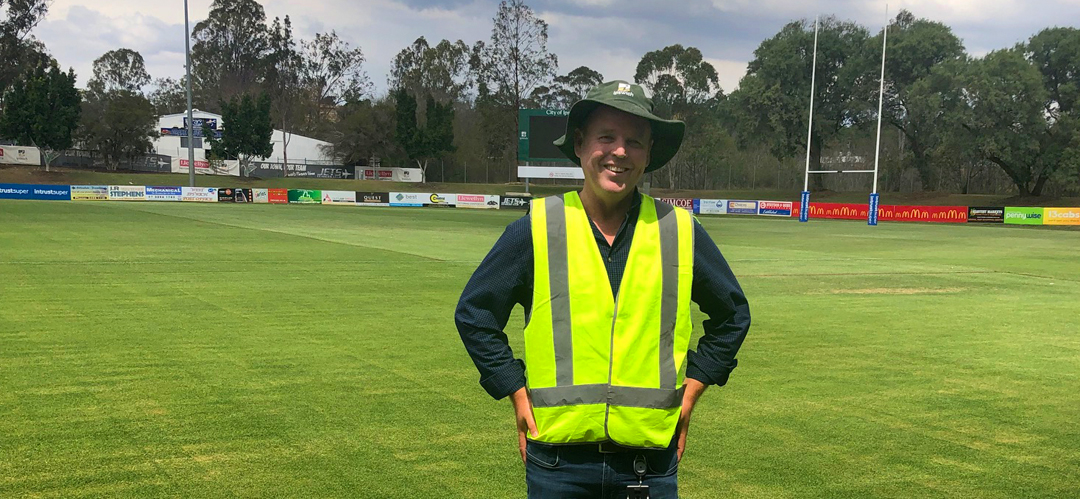
James Hilyard is Ipswich City Council’s Infrastructure and Environment Department, Acting City Maintenance manager.
James is a horticulturalist, arborist and holds a masters degree in sustainability.
In this month’s column, James shares five interesting Christmas themed gardening facts.
Ever wished your lawn could look like the local bowling club or have the pretty chequered patches mowed into it with military precision?
Not a blade out of place or weed to be seen?
Well, now is the time to renovate your lawn.
After such a long dry spell your lawn has no doubt suffered and when the desirable species of turf grass thin out, weakens or dies the opportunistic weeds can get a good foothold and take over.
They can be difficult to control and if you do nothing your lawn may become a field of weeds rather than a field of dreams.
But now the rain has come it’s time to get your grass back into shape.
Ideally, you want a consistent covering of the same species of grass.
This means that the level of growth is the same with the same colour and texture of grass across your lawn.
In our sports fields we even aim to have the same varieties of a species of grass.
This is the only way we can get a perfect coverage of lush green turf – a monoculture.
Nature doesn’t like monocultures and there is nothing natural about sports turf other than it’s a living thing.
Most varieties of grass used are hybrids bred for disease resistance, resistance to wear and tear and grown to be aesthetically pleasing.
On a large scale we use lots of heavy duty equipment to scarify, aerate, slice, verticut, vertidrain and top dress.
A home gardener often doesn’t have access to this kind of equipment.
You can hire some of it but it’s an expense a lot of us just can’t justify in our weekly budgets.
So what can we do?
We can still renovate and improve our lawns for a relatively small outlay and we should do it now, when it’s actively growing.
Did you know?
- Grass has the same cooling effect as open water or a pool but loses 40% less water through evaporation
- The average home’s lawn is twice as effective in providing cooling services as the average house’s ducted air conditioning system
- Artificial grass is 40% hotter than real grass
- Lawns can break down organic pollutants and are a good way of recycling water
- Lawns reduce ambient noise making cities quieter and more liveable
Not to mention the aesthetic benefits of nice green grass to play on.

- Mow the grass as low as you can with your mower.
Put it on the lowest setting and use a catcher.
You might kick up a bit of dirt or mud so make sure you were the appropriate safety clothing.
Collect all the clippings and compost them.
This will remove all of the old thatch in the lawn and let air, water and fertiliser penetrate to the soil below. - Apply a complete granule fertiliser and water in well. Leave it for two or three days and let the grass recover.
- Use a selective herbicide to kill your unwanted weed species.
Ask your local supplier what is best for your lawn and the weed species that you have present.
Be Careful. The chemical to kill nut grass for example will also kill Kikuyu which is a desirable grass species.
The easiest option for a couch grass lawn is to use weed and feed.
Again, always wear appropriate clothing. - Topdress, using a suitable sandy loam type soil, not compost, potting mix or sand.
Fill in all of the holes, divots, cracks and ruts in your soil.
Level the soil out out using a large piece of wood or rake.
I like to use a three metre long piece of wood and get one person on each end and level the soil out like I was preparing a surface for paving.
Try to avoid applying soil too thick or the grass will struggle to push through.
A maximum of 2.5cm should be used as a rule of thumb.
Make sure you don’t use straight sand, which is a common mistake.
You need a loamy soil that will hold a bit of moisture and provide some nutrients. - Then stand back, water and let nature do her thing.
You should get a lovely, flat, healthy green lawn you can be proud of.


